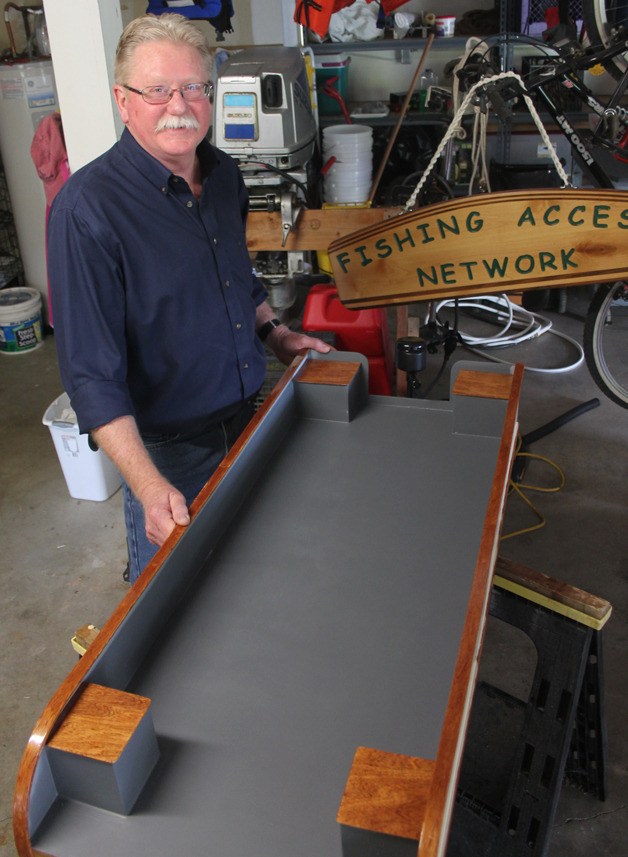People in the world of getting paralyzed veterans active are excited about a Freeland man’s quest to help them cast a line.
Mike Mayes, the fishing guru at Freeland Ace Hardware, has worked for the past several years on a pontoon that can support a couple of power wheel chairs to get disabled veterans on the water.
“If you’ve ever been on a boat with one of these kids who’s never been on one before … the look on their face, it almost makes you cry,” Mayes said.
Later, he added: “I have more fun doing this than anything else. Doing this, which puts a grin on someone else’s face, is priceless.”
 Now, the struggle is using that enthusiasm to find people willing to fund Mayes’ startup company, ADA Boats Inc., and convincing disabled veterans to actually get out and onto the boats.
Now, the struggle is using that enthusiasm to find people willing to fund Mayes’ startup company, ADA Boats Inc., and convincing disabled veterans to actually get out and onto the boats.
“A lot of guys in wheelchairs up until Mike Mayes came along [stayed home]. It’s been pretty difficult to get a guy in a wheelchair that weighs 450 pounds into a boat,” said Mike Davis, the fishing and shooting sports director of Paralyzed Veterans of America’s Northwest Chapter.
Two years after unveiling his prototype, the Accessible, on Lone Lake with Fishing Access Network partner Ralph Brother, Mayes is on the cusp of breaking into full-fledged production with his company ADA Boats Inc. To get some seed money to build a demo boat with a higher weight capacity and show it off at an exposition in San Jose this fall, Mayes started a Kickstarter online fund-raising campaign to raise $15,000. To date, he’s raised about 10 percent of that with two weeks left in the drive.
The prospect of getting paraplegic and quadriplegic people out on the water, casting for trout and bass, had Davis buzzing.
“I’m pushing his program hard and heavy with the VA [Veterans Administration], and boy do I have a lot of interest,” Davis said.
He later added: “I was so sold on it before he even built his first one that I talked our group, the Paralyzed Veterans … into making a really nice donation to Mike so it would propagate his program.”
The plywood pontoons measure 15 long, 10 feet wide and 7 feet deep. After some retooling of the prototype, he increased its capacity to 2,000 pounds (a ton) though it takes 7,000 pounds to sink the sturdy box that admittedly gets few points for form but plenty of appreciation for its function. In practice, the pontoon could take on two paralyzed boaters in power chairs plus a few other people, or four manual chairs with a couple of friends.
“The thing can float way more people than we can get on it,” Mayes said.
Plenty of precautions were taken to ensure the chair-bound anglers’ safety. Mayes said everyone on his boats, while out with him, is required to wear a personal flotation device; those in wheelchairs would not be buckled to the chair; and the sides of the boats were walled in to prevent any sliding out.
Davis and his group were instrumental in providing feedback to Mayes, who made his United States Coast Guard-certified pontoon more stable.
“I don’t need it to rock a lot,” Mayes laughed.
Mayes’ boats can be built without one of the seat/storage boxes at the stern, which would allow someone in a wheelchair to operate the motor. He was also considering the possibility of using a remote control for the motor as a means for a paralyzed person to load the boat into the water alone, if they so desired.
“[Being] active is mentally healthy, active is pure and simply health for everyone, to get up, get out,” Davis said. “From my experience of having been in the position for so long, out of 300 hundred catastrophically injured individuals, 200 of them will stay home and never go out and do nothing but take care of their bowel system. To have special programs that allow them to get out of the house, to go clam digging, to get in the van and ride around in the parking lot while someone else digs the clams, it gets them out of the house.”
Boat business
If he were to get as few as five boat orders, each costing about $10,000 and taking as long as eight weeks to build, Mayes said he would go into production with a five-member staff. That would require between 4,000 and 6,000 square feet, and Mayes estimated being able to build 20 boats in the first year of full-scale production, and up to 100 pontoons in the second year, if there were enough orders.
Davis, who has worked to get paralyzed veterans out and about for the past 18 years, said the potential in the pontoons is vast.
“This design that Mike Mayes has with his pontoon boats, I don’t know of anybody that’s doing it with the completeness that he’s put to it,” Davis said. “I think he’ll be a leader in the field if we can put together a program where we show that we have people from the VA hospital coming. With some attention, it can take off.”


